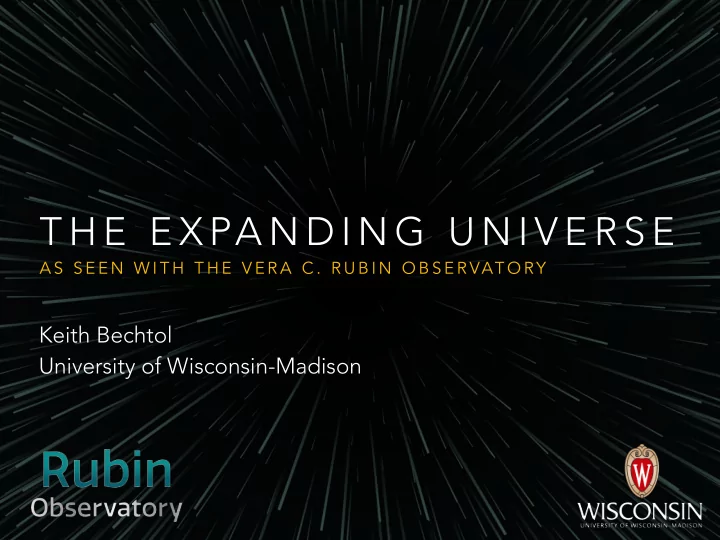

T H E E X PA N D I N G U N I V E R S E A S S E E N W I T H T H E V E R A C . R U B I N O B S E R VAT O RY Keith Bechtol University of Wisconsin-Madison
Apparent Recession Speed Distance
The first Hubble Diagram (1929) Apparent Recession Speed Distance
Apparent Recession Speed Expansion rate today ~ 70 km s -1 Mpc -1 (modern measured value) Distance
Two contributions to an apparent wavelength shift
Two contributions to an apparent wavelength shift Relativistic Doppler Effect Tells us relative velocity between emitter and observer
Two contributions to an apparent wavelength shift Relativistic Doppler Effect Cosmological Redshift Tells us relative velocity between Tells us relative size of Universe emitter and observer when light was emitted
Two contributions to an apparent wavelength shift Relativistic Doppler Effect Cosmological Redshift Tells us relative velocity between Tells us relative size of Universe emitter and observer when light was emitted
Before Image credit: DES
Before After supernova Image credit: DES
Before After supernova ~10 36 Watt Image credit: DES Type Ia supernovae are explosions of known intrinsic luminosity (1) Observed flux → distance → light travel time from when supernova exploded (2) Redshift → size of Universe when supernova exploded
Apparent Recession Speed Expansion rate today ~ 70 km s -1 Mpc -1 Distance
Apparent Recession Speed (Size of Universe) Expansion rate today ~ 70 km s -1 Mpc -1 Distance (Age of Universe)
Apparent Recession Speed (Size of Universe) Expansion rate today ~ 70 km s -1 Mpc -1 Distance (Age of Universe)
Slope tells us the matter-energy density of the Universe Apparent Recession Speed (current value is equivalent to ~6 protons per cubic meter) (Size of Universe) Expansion rate today ~ 70 km s -1 Mpc -1 Distance (Age of Universe)
The inverse of the slope tells us the Apparent Recession Speed approximate age of the Universe (~14 billions years) (Size of Universe) Expansion rate today ~ 70 km s -1 Mpc -1 Distance (Age of Universe)
The inverse of the slope tells us the Apparent Recession Speed approximate age of the Universe (~14 billions years) (Size of Universe) T H E R AT E O F E X PA N S I O N H A S C H A N G E D T H R O U G H O U T C O S M I C H I S T O RY Distance (Age of Universe)
Image adapted from David Kirkby CMB z = 1 Now (age ~ 380,000 yr) (age ~ 6 Gyr) (age ~ 13.8 Gyr) Expansion Rate Size of Universe
Image adapted from David Kirkby CMB z = 1 Now (age ~ 380,000 yr) (age ~ 6 Gyr) (age ~ 13.8 Gyr) R a d i a t i o n - d o m i n Expansion Rate a t e d M a t t e r - d o m i n a t e d Dark Expansion rate controlled by matter-energy components Energy! Size of Universe
Image adapted from David Kirkby CMB z = 1 Now (age ~ 380,000 yr) (age ~ 6 Gyr) (age ~ 13.8 Gyr) Radiation 𝝇 ~ a -4 w = +1/3 Energy Density 𝝇 ~ a -3 w = 0 (Dark) Matter 𝝇 ~ const. w = -1 Dark Energy Size of Universe
Image adapted from David Kirkby CMB z = 1 Now (age ~ 380,000 yr) (age ~ 6 Gyr) (age ~ 13.8 Gyr) Radiation 𝝇 ~ a -4 w = +1/3 Energy Density 𝝇 ~ a -3 w = 0 (Dark) Matter 𝝇 ~ const. w = -1 Dark Dark energy density equivalent Energy to ~4 protons per cubic meter Size of Universe
Image adapted from David Kirkby CMB z = 1 Now (age ~ 380,000 yr) (age ~ 6 Gyr) (age ~ 13.8 Gyr) Fraction of Total Energy Density All Matter Radiation Dark Atoms Energy Size of Universe
All observations from the present day to ~1 second after the Big Bang can be explained by a “simple” cosmological model…
All observations from the present day to ~1 second after the Big Bang can be explained by a “simple” cosmological model… However, this model has five distinct lines of evidence for new physics: Dark Matter Dark Energy Massive neutrinos Inflation Matter-antimatter asymmetry
Type Ia supernova occur roughly once per century in a large galaxy like the Milky Way… Image credit: HSC
Type Ia supernova occur roughly once per century in a large galaxy like the Milky Way… Image credit: HSC Legacy Survey of Space and Time (LSST) will monitor >10 billion galaxies over 10 years, yielding a sample of ~1 million type Ia supernovae across billions of years of cosmic time
What is the Universe expanding into? It’s more appropriate to think of cosmic expansion in terms of the typical physical separation between galaxies increasing, and the density of matter decreasing Are we at the center of the Universe? No more than anyone else; there are no preferred positions (homogenous) or directions (isotropic) Can galaxies recede faster than the speed of light? Yes, Special Relativity does not apply to apparent recession speed due to cosmic expansion Can we see galaxies receding faster than speed of light? Yes, because the expansion rate has changed over time How large is the observable Universe? Because space is expanding, the observable part of our Universe has a radius of more than 14 billion light years Is the Earth / Solar System / Milky Way expanding? No, gravitationally bound objects remain in equilibrium How will the Universe end? Cold, dark, and lonely, according to the current cosmological model
References “ Misconceptions About the Big Bang ” Charles H. Lineweaver & Tamara M. Davis, Scientific American, 2005 Scientifically curious audiences “ Introduction to Cosmology ” Barbara Ryden Undergraduate level textbook “Modern Cosmology” Scott Dodelson Graduate level textbook
Recommend
More recommend